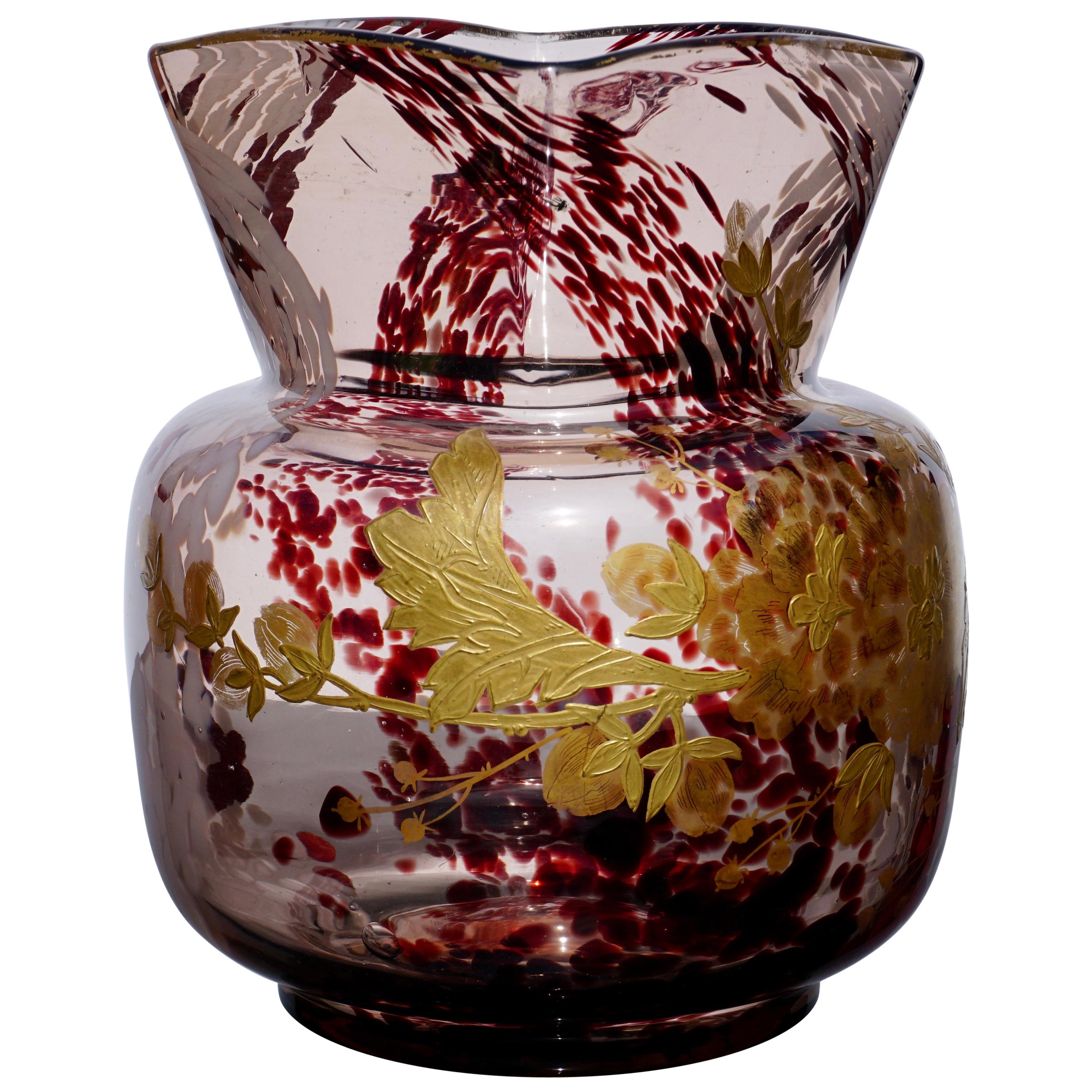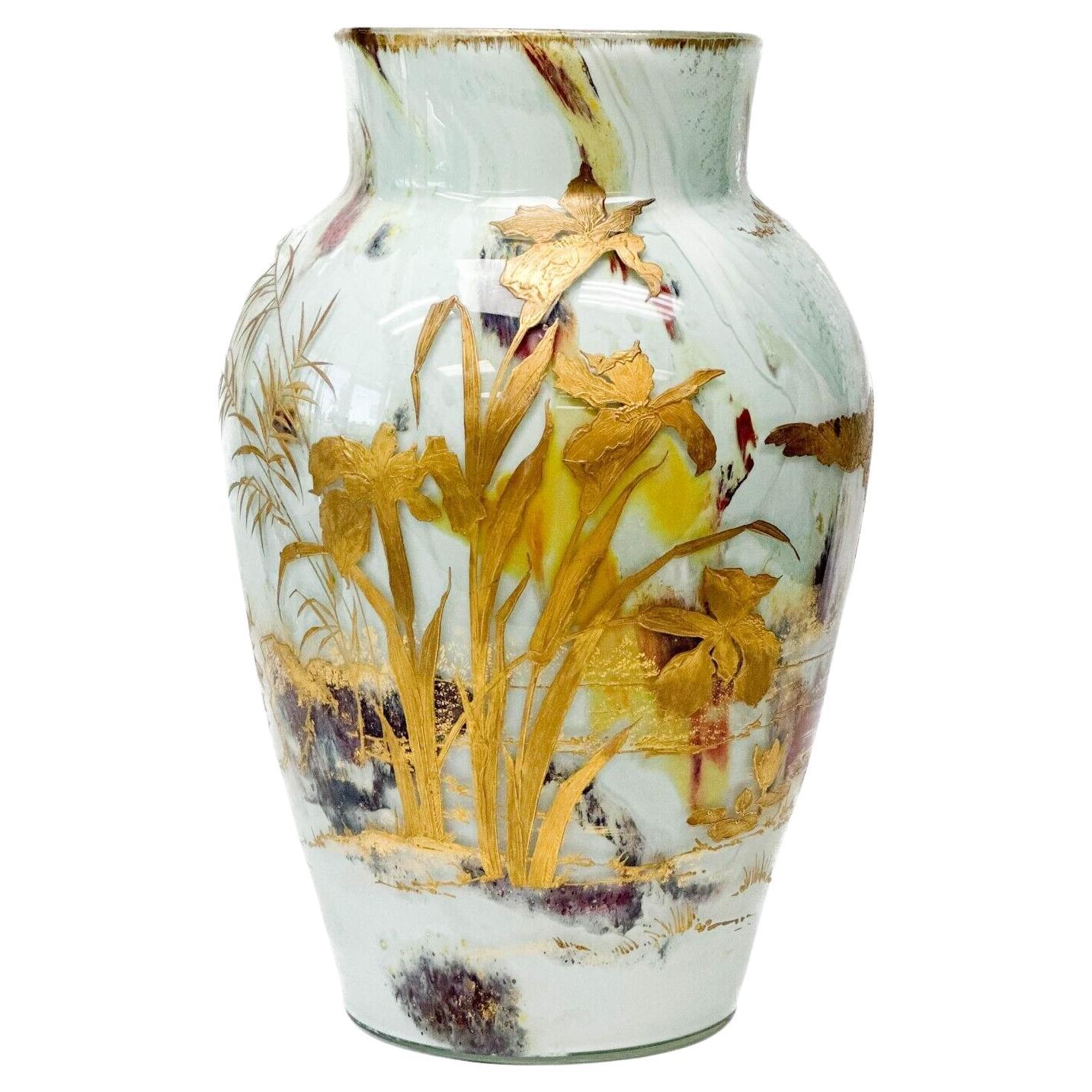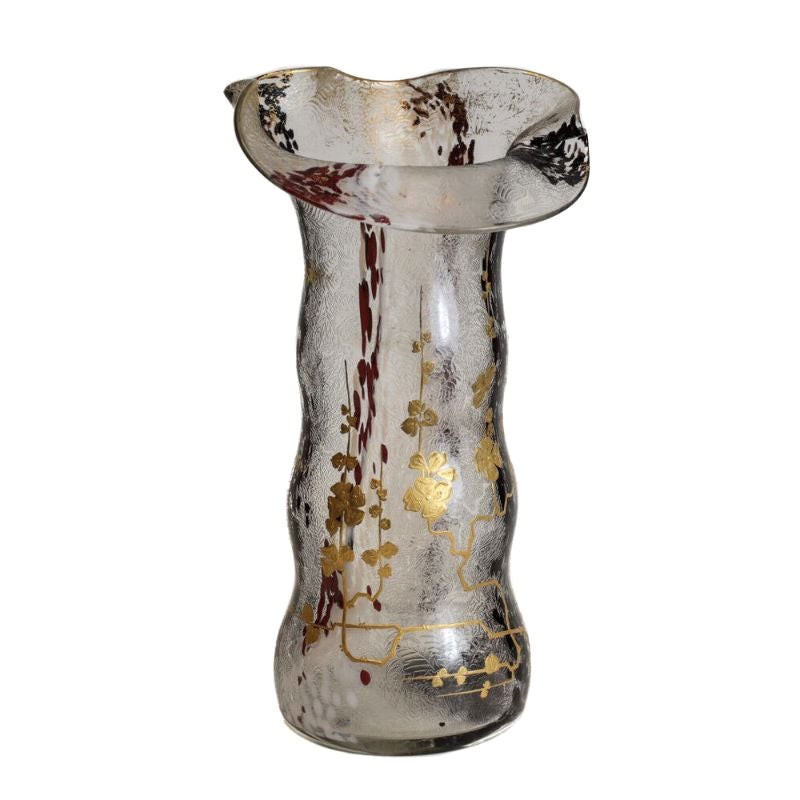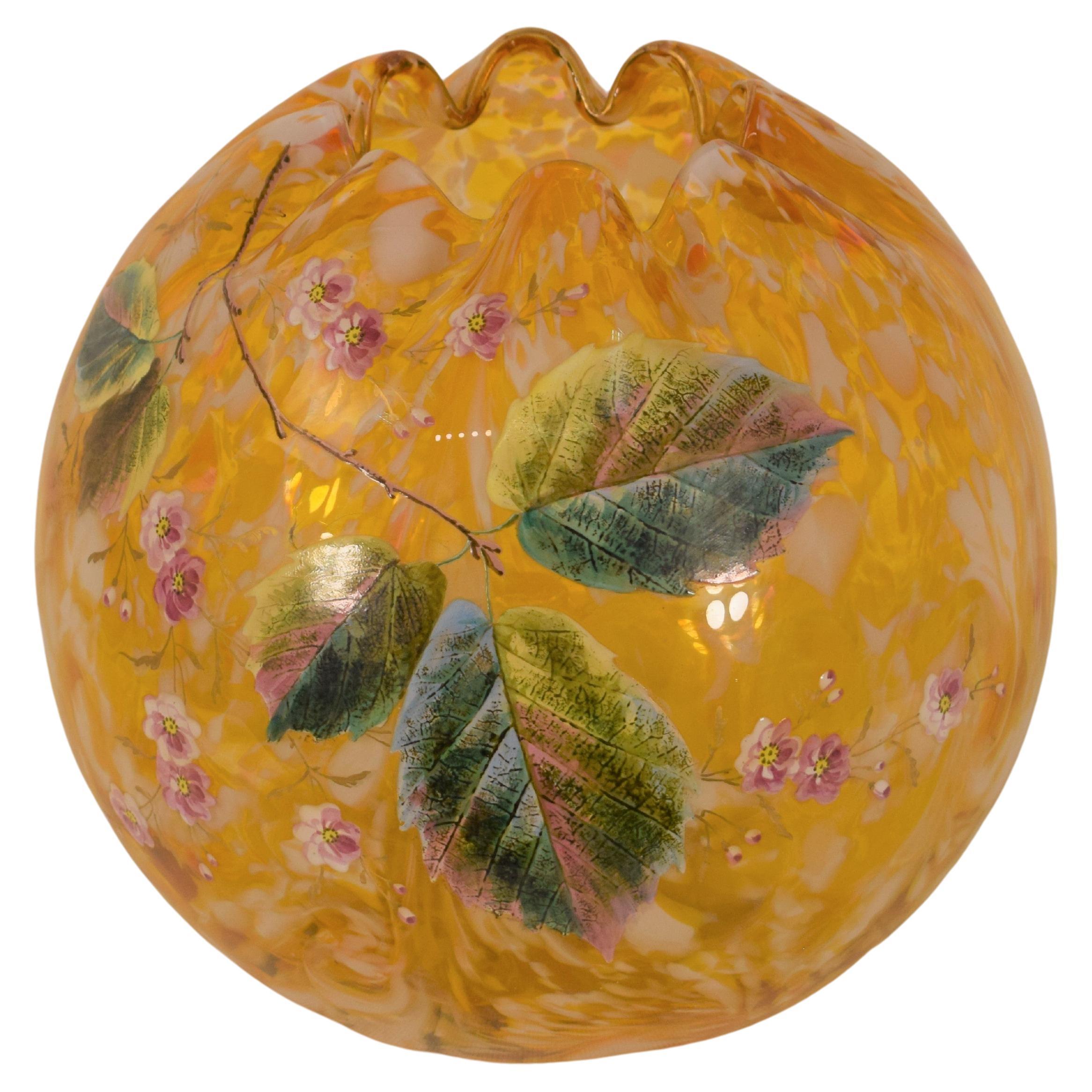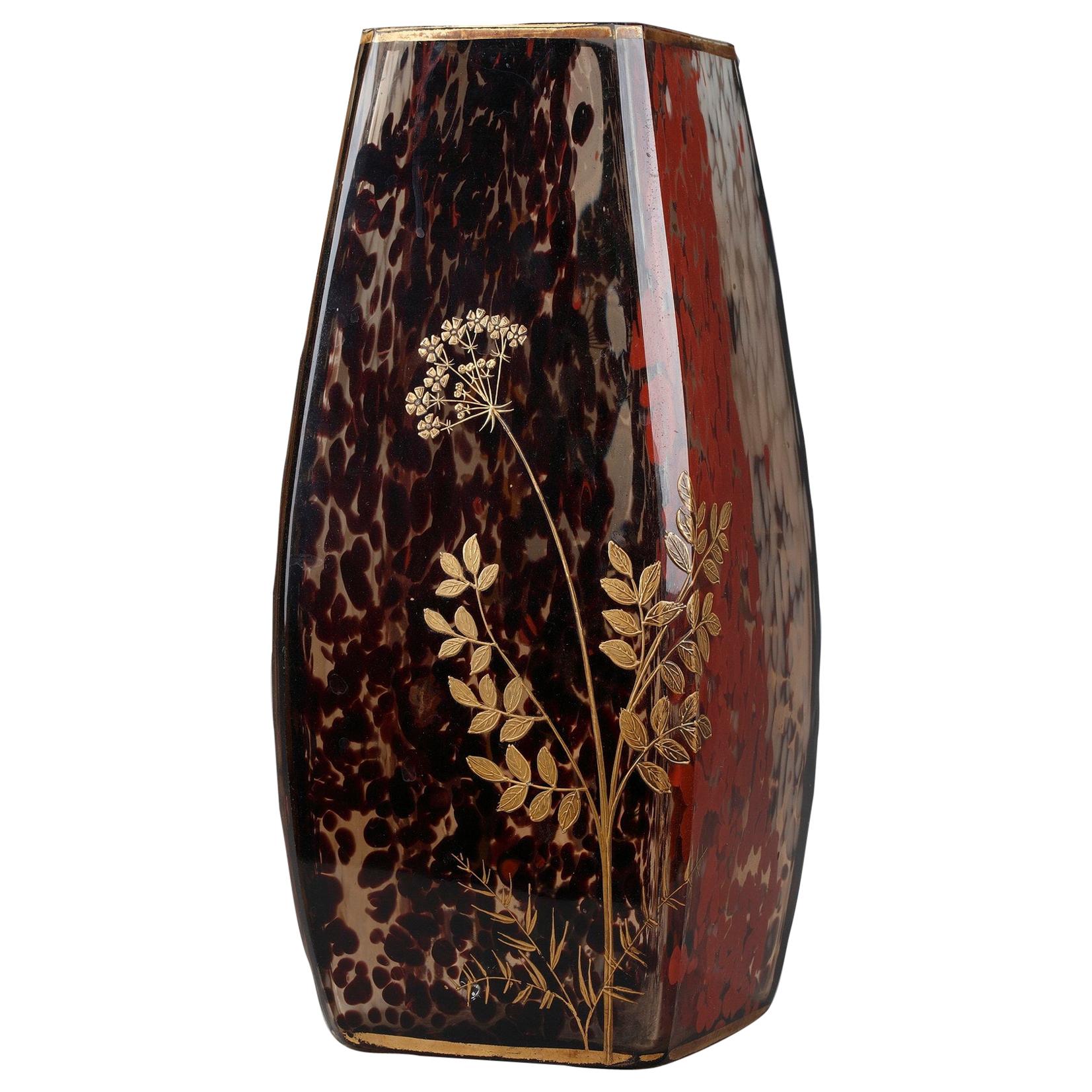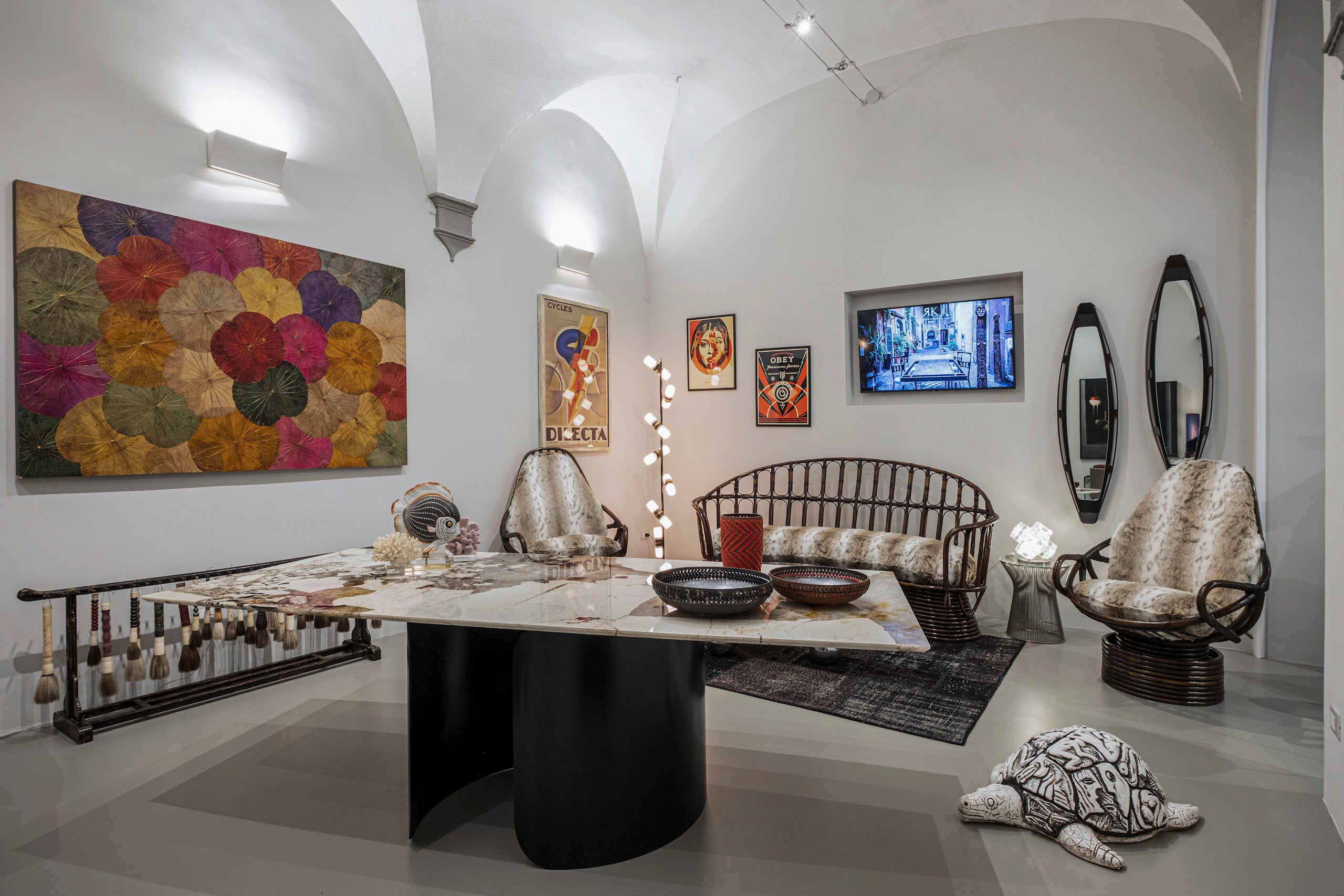Items Similar to Ernest Baptiste Leveille Glass Vase with Gilt and Enamel Mimosas
Want more images or videos?
Request additional images or videos from the seller
1 of 9
Ernest Baptiste Leveille Glass Vase with Gilt and Enamel Mimosas
About the Item
Rare and important vase in amethyst glass, exquisitely painted in gilt enhanced with enamelling and glass beads. The painted design of a Mimosa branch in bloom extends to three sides of the vase. The gilt painting is enhanced with glass beads and white enamel flowers.
Ernest-Baptiste Leveillé had a shop at 74 Boulevard Haussmann, Paris. He was a member of the Paris 'art-glass' fraternity and a pupil of François-Eugène Rousseau, one of the movement's founders and this piece was probably made around 1885 when Leveillé took over Rousseau's own decorating workshop and shop at 43 rue Coquillère, Paris. Leveillé's glass ranges from pieces like this one influenced by the style of Japanese lacquer to works in mottled and splashed glass imitating agates.
- Attributed to:Ernest Baptiste Leveille (Maker)
- Dimensions:Height: 7.49 in (19 cm)Diameter: 4.73 in (12 cm)
- Style:Art Nouveau (Of the Period)
- Materials and Techniques:
- Place of Origin:
- Period:
- Date of Manufacture:1900
- Condition:Wear consistent with age and use. Minor losses. While some of the gilt work has faded around the mouth of the vase, the rest of the gilding is in excellent condition as is the enamelling. Four of the glass beads have been lost as is consistent with age and use, no chips or fractures.
- Seller Location:Roma, IT
- Reference Number:1stDibs: LU6910231739292
KalaRara
KalaRara specializes in the design and production of one-of-a-kind and limited edition tables, consoles and wall decor. All of our pieces are made by hand, to the highest standards, by artisans and master craftsmen in our workshops. Utilizing sustainable materials like fragments of Murano glass and recyclable metals such as: stainless-steel, brass and iron, in a variety of finishes, each creation is a functional piece of art. In keeping with our philosophy of sustainable design we also offer a curated selection of antique and vintage pieces, some of which have been respectfully modified for contemporary living.
About the Seller
5.0
Vetted Seller
These experienced sellers undergo a comprehensive evaluation by our team of in-house experts.
Established in 2018
1stDibs seller since 2022
- ShippingRetrieving quote...Ships From: Roma, Italy
- Return PolicyA return for this item may be initiated within 7 days of delivery.
More From This SellerView All
- Large Murano Crackle Glass Vase With Fused Faceted Glass Block BaseBy Paolo VeniniLocated in Roma, RMThis large unique Murano glass vase was made using the "Ghiachciato" technique, that gives the surface of the glass an irregular crackled appearance. The effect is created by submerg...Category
Vintage 1980s Italian Mid-Century Modern Vases
MaterialsMurano Glass
- Murano Glass "Bullicante" Vase Signed by Franco MorettiBy Franco MorettiLocated in Roma, RMMid-Century Modern iridescent transparent vase, signed Franco Moretti, Murano – Venice, 1970's. Triangular-shaped vase with round base and bubble inclus...Category
Vintage 1970s Italian Mid-Century Modern Vases
MaterialsMurano Glass
- Murano Glass Crepuscolo Vase by Ercole Barovier for Barovier & TosoBy Ercole BarovierLocated in Roma, RMRare and impressive "Crepuscolo" Murano glass vase from the late 1930's. Designed by the legendary Creative Director Ercole Barovier, employing his technique of inserting steel wool ...Category
Vintage 1930s Italian Mid-Century Modern Vases
MaterialsMurano Glass
- Pair of Ceramic Vases by Guido Andlovitz for S.C.I. LevanoBy Guido AndlovitzLocated in Roma, RMOriginally designed by architect, designer and artistic director Guido Andlovitz in 1936 for Società Ceramica Italiana Laveno, this pair of vases are indeed the rarest of finds. The vases were manufactured in 1942, as attested to by the marking "N - 42" on the base of each vase. The gold rims and aquatic scenes that surround each vase, are unique to each piece and were painted by hand in 1943. They are both signed by the artist "Miruccia". One of the vases has the words “Anni di Guerra” (Year of War) written on the base in reference to the Second World War . Founded in Laveno in 1856 by Severino Revelli and some former employees of the "Richard" manufacturer in Milan. The "SCI" (Italian Ceramic Society) began its activity as a manufacturer of wall tiles and fine tableware. In 1883 it became a limited company and obtained its first successes at numerous national exhibitions. In 1895, Cavalier Luciano Scotti took over the company and, thanks to his intuition and his entrepreneurial skills, the factory grew substantially in a few years. In those years, some Liberty-style pieces designed by Giorgio Spertini, the author of noteworthy elegant "whiplash" creations, were created in the Laveno factory. In 1906 "SCI" presented numerous works at the International Exhibition of Decorative Arts in Milan. Other collaborators from the beginning of the century were Silvio and Piero De Ambrosis, Felice Palucco, Giancarlo Jacopini and the brothers Marco and Luigi Raggiori. However, it was in 1923 that, under the direction of Guido Andlovitz, the company reached the peak of its fame and in 1925 was a resounding success at the 2nd Monza Biennale. Andlovitz, who collaborated with the manufacturer for almost forty years, applied to the production process the principle of seriality, a concept also put into effect by Giò Ponti at "Richard-Ginori", adopting various types of decoration which, although moulded and decal stamped, still retained an undeniable elegance. In 1924 the "Società Ceramica Revelli" became a consortium with the "SCI", the partnership would continue until 1932 and saw Franco Revelli's company marketing pottery and table porcelain on behalf of "SCI". From 1925 porcelain and crockery began to appear in the factory's catalogs. In 1927 the company was present at the 3rd Biennial of Decorative Arts in Monza. Between the end of the 1920's and the beginning of the 1930's, the decorators Giuseppe Bellorini and Daniela Ferretto began to collaborate with the "SCI". As of 1932 the company managed two factories: that of Laveno, which, with over 1300 employees, produced strong pottery, tableware and artistic ceramics and the smaller factory of Verbano, which employed about 400 people and produced, in addition to ceramics for the electrotechnical industry, excellent table porcelain. The products were marketed in the company owned stores in Rome, Genoa and Naples. This was an initiative realised by Andlovitz himself. In the mid-thirties, the decorators Ada Corsi and Ida Fonini among others, collaborated with the "SCI". From 1936 to 1940 the artistic direction of the company was entrusted to the sculptor and modeler Angelo Biancini. In 1939 about 1300 people worked in the Laveno plant and in 1951 about 2300. In the years between the two wars among the collaborators of the factory were Sirio Tofanari...Category
Vintage 1940s Italian Mid-Century Modern Vases
MaterialsCeramic
- Early 19th Century English Demilune Lusterware Bough Pot With CoverBy Hackwood & Co.Located in Roma, RMThis demilune flower pot or bough pot for forcing springtime bulbs, is adorned with three landscape panels. Each panel, painted in pink lustre, depicts the same cottage in a pastoral setting from three different vantage points. Moulded into the top and bottom rims are acanthus leaves. Pieces in this shape, color and style have been attributed to the Hackwood company, and usually pieces like these, are not marked. William Hackwood & Son was an earthenware factory in Shelton, England, from 1818 until 1853. In addition to lustre ware...Category
Antique Early 19th Century British Planters, Cachepots and Jardinières
MaterialsCeramic, Faience, Luster
- "Callisto's Crossing" Glass Topped Dining Table On Black Enameled Iron BaseBy KalararaLocated in Roma, RM“CALLISTO CROSSING’S” is a one-of-a-kind table, designed and manufactured by KalaRara. The tabletop is realised in fragmented Murano glass with insets of weathered and distressed lea...Category
21st Century and Contemporary Italian Dining Room Tables
MaterialsStainless Steel
You May Also Like
- Ernest Baptiste Leveille Tall Gilt Bamboo VaseBy Ernest Baptiste LeveilleLocated in Dallas, TXThese vases are hidden gems in the art glass world as they are never signed. Made by Earnest Baptiste Leveille in collaboration with Eugene Rousseau in...Category
Antique Early 1900s French Art Nouveau Vases
MaterialsArt Glass
- Ernest Baptiste Leveille Art Nouveau Gilt Floral VaseBy Ernest Baptiste LeveilleLocated in Dallas, TXThese vase are hidden gems in the art glass world as they are never signed. Made by Earnst Leveille in collaboration with Eugene Rouseau in Paris, circa 1900; this vase in glass blow...Category
Antique Early 1900s French Art Nouveau Vases
MaterialsArt Glass
- Ernest Baptiste Leveille Opaque Art Glass Vase, c1900 Gilt FloralsBy Ernest Baptiste LeveilleLocated in Gardena, CAErnest Baptiste Leveille Opaque Art Glass Vase, c1900 Gilt Florals Opaque glass internally decorated with yellow, red, and blue, silver metal flakes...Category
Antique 19th Century French Vases
MaterialsArt Glass
- Stunning Ernest Baptiste Leveille Art Glass Vase Acid Etched & Gilt, C1900By Ernest Baptiste LeveilleLocated in Gardena, CAStunning Ernest Baptiste Leveille Art Glass Vase Acid Etched & Gilt, c1900 Beautiful acid etched florals and leaves to the interior of the vase gilt and other multi-colored design...Category
Antique 19th Century French Vases
MaterialsArt Glass
- Ernest Baptiste Leveille, Vase Art Nouveau, France, 1910sBy Ernest Baptiste LeveilleLocated in Palermo, PAErnest baptiste leveille, vase art nouveau, France, 1910s. Dimensions: H= 21 cm; D= 21 cm.Category
Vintage 1910s French Mid-Century Modern Vases
MaterialsGlass
- Art Nouveau Speckled Glass Vase Attributed to Ernest LéveilléLocated in Paris, FRLate 19th century Art Nouveau cylindrical vase. The brown and red speckles create a dynamic pattern that is complemented by the gold umbelliferous plants. Attributed to Ernest Léveillé (1841-1913). Circa :1900 Dimension: W: 5.3 in, D: 5.3in, H: 11.8in. Dimension: L: 13.5cm, P: 13.5cm, H: 30cm. Ernest-Baptiste Léveillé (1841-1913), also known as Ernest Léveillé, was a porcelain and crystal manufacturer, active in the second half of the 19th century and the beginning of the 20th century. He is best known for his porcelain, but he also made Japanese vases, bamboo vases, ovoid and cylindrical vases decorated with plants... Founder of the Léveillé house in 1869 at 74 boulevard Haussmann in Paris, Léveillé acquired in 1885 the house E. Rousseau, a porcelain and crystal manufacturer, and operated the business from 1886 to 1890 under the name Maison Rousseau et Léveillé réunies. Léveillé created the models and had them executed and engraved. His cracked and engraved vases earned him a gold medal. When Eugène...Category
Antique Late 19th Century French Art Nouveau Vases
MaterialsGlass
Recently Viewed
View AllMore Ways To Browse
Shops Around
Antique Glass Bead
Antique Glass Beads
Glass Beads Antique
Antique Shop Design
Antique Piece Shop
Antique Hand Painted Glass Vases
Antique Hand Painted Glass Vase
Splash Glass
Beaded Vase
Glass Hand Painted French Vase
A Vases Beads
Vases Of Beads
1900 Japanese Vase
Art Nouveau Glass Enamel Vase
Amethyst Glass Vases
Antique Amethyst Glass
Lacquer Glasses Japan

